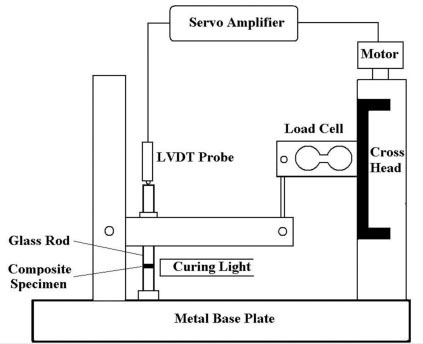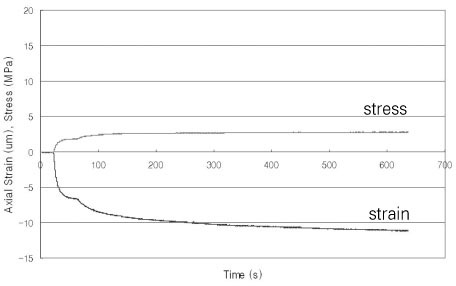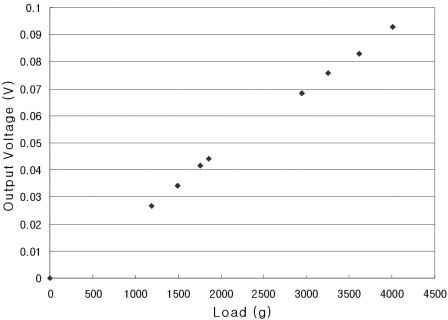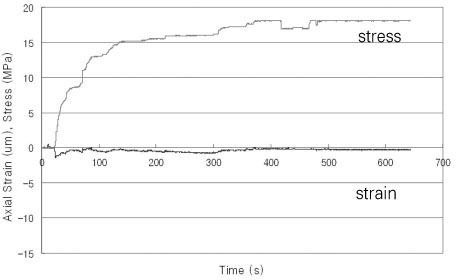Articles
- Page Path
- HOME > Restor Dent Endod > Volume 34(2); 2009 > Article
- Original Article Effect of instrument compliance on the polymerization shrinkage stress measurements of dental resin composites
- Deog-Gyu Seo1, Sun-Hong Min2, In-Bog Lee2
-
2009;34(2):-153.
DOI: https://doi.org/10.5395/JKACD.2009.34.2.145
Published online: March 31, 2009
1Department of Conservative Dentistry, College of Dentistry, Yonsei University, Korea.
2Department of Conservative Dentistry, School of Dentistry, Seoul National University, Korea.
- Corresponding Author: In-Bog Lee. Department of Conservative Dentistry, School of Dentistry, Seoul National University, 275-1 Yeongeon-Dong, Jongno-Gu, 110-768, Korea. Tel: 82-2-2072-3953, Fax: 82-2-2072-3859, inboglee@snu.ac.kr
Copyright © 2009 The Korean Academy of Conservative Dentistry
- 987 Views
- 1 Download
- 4 Crossref
Abstract
-
The purpose of this study was to evaluate the effect of instrument compliance on the polymerization shrinkage stress measurements of dental composites. The contraction strain and stress of composites during light curing were measured by a custom made stress-strain analyzer, which consisted of a displacement sensor, a cantilever load cell and a negative feedback mechanism. The instrument can measure the polymerization stress by two modes: with compliance mode in which the instrument compliance is allowed, or without compliance mode in which the instrument compliance is not allowed.A flowable (Filtek Flow: FF) and two universal hybrid (Z100: Z1 and Z250: Z2) composites were studied. A silane treated metal rod with a diameter of 3.0 mm was fixed at free end of the load cell, and other metal rod was fixed on the base plate. Composite of 1.0 mm thickness was placed between the two rods and light cured. The axial shrinkage strain and stress of the composite were recorded for 10 minutes during polymerization, and the tensile modulus of the materials was also determined with the instrument. The statistical analysis was conducted by ANOVA, paired t-test and Tukey's test (α<0.05).There were significant differences between the two measurement modes and among materials. With compliance mode, the contraction stress of FF was the highest: 3.11 (0.13), followed by Z1: 2.91 (0.10) and Z2: 1.94 (0.09) MPa. When the instrument compliance is not allowed, the contraction stress of Z1 was the highest: 17.08 (0.89), followed by FF: 10.11 (0.29) and Z2: 9.46 (1.63) MPa. The tensile modulus for Z1, Z2 and FF was 2.31 (0.18), 2.05 (0.20), 1.41 (0.11) GPa, respectively. With compliance mode, the measured stress correlated with the axial shrinkage strain of composite; while without compliance the elastic modulus of materials played a significant role in the stress measurement.
- 1. Braga RR, Ferracane JL. Alternatives in polymerization contraction stress management. Crit Rev Oral Biol Med. 2004;15(3):176-184.ArticlePubMed
- 2. Kleverlaan CJ, Feilzer AJ. Polymerization shrinkage and contraction stress of dental resin composites. Dent Mater. 2005;21(12):1150-1157.ArticlePubMed
- 3. Song YX, Inoue K. Linear shrinkage of photo-activated composite resins during setting. J Oral Rehabil. 2001;28(4):335-341.ArticlePubMed
- 4. Lee IB, Cho BH, Son HH, Um CM. A new method to measure the polymerization shrinkage kinetics of light cured composites. J Oral Rehabil. 2005;32(4):304-314.ArticlePubMed
- 5. Dauvillier BS, Aarnts MP, Feilzer AJ. Developments in shrinkage control of adhesive restoratives. J Esthet Dent. 2000;12(6):291-299.ArticlePubMed
- 6. Carvalho RM, Pereira JC, Yoshiyama M, Pashley DH. A review of polymerization contraction: the influence of stress development versus stress relief. Oper Dent. 1996;21(1):17-24.PubMed
- 7. Park J, Chang J, Ferracane J, Lee IB. How should composite be layered to reduce shrinkage stress: incremental or bulk filling? Dent Mater. 2008;24(11):1501-1505.ArticlePubMed
- 8. Lee MR, Cho BH, Son HH, Um CM, Lee IB. Influence of cavity dimension and restoration methods on the cusp deflection of premolars in composite restoration. Dent Mater. 2007;23(3):288-295.ArticlePubMed
- 9. Labella R, Lambrechts P, Van Meerbeek B, Vanherle G. Polymerization shrinkage and elasticity of flowable composites and filled adhesives. Dent Mater. 1999;15(2):128-137.ArticlePubMed
- 10. Guggenberger R, Weinmann W. Exploring beyond methacrylates. Am J Dent. 2000;13(Spec No):82D-84D.PubMed
- 11. Chantler PM, Hu X, Boyd NM. An extension of a phenomenological model for dental composites. Dent Mater. 1999;15(2):144-149.ArticlePubMed
- 12. Venhoven BA, de Gee AJ, Davidson CL. Light initiation of dental resins: dynamics of the polymerization. Biomaterials. 1996;17(24):2313-2318.ArticlePubMed
- 13. Feilzer AJ, De Gee AJ, Davidson CL. Setting stress in composite resin in relation to configuration of the restoration. J Dent Res. 1987;66(11):1636-1639.PubMed
- 14. Park J, Chang J, Ferracane J, Lee IB. How should composite be layered to reduce shrinkage stress: incremental or bulk filling? Dent Mater. 2008;24(11):1501-1505.ArticlePubMed
- 15. Lutz E, Krejci I, Oldenburg TR. Elimination of polymerization stresses at the margins of posterior composite resin restorations: a new restorative technique. Quintessence Int. 1986;17(12):777-784.PubMed
- 16. Bowen RL, Nemoto K, Rapson JE. Adhesive bonding of various materials to hard tooth tissues: forces developing in composite materials during hardening. J Am Dent Assoc. 1983;106(4):475-477.ArticlePubMed
- 17. Bowen RL. Adhesive bonding of various materials to hard tooth tissues. VI. Forces developing in direct-filling materials during hardening. J Am Dent Assoc. 1967;74(3):439-445.ArticlePubMed
- 18. Hegdahl T, Gjerdet NR. Contraction stresses of composite resin filling materials. Acta Odontol Scand. 1977;35(4):191-195.ArticlePubMed
- 19. Bouschlicher MR, Vargas MA, Boyer DB. Effect of composite type, light intensity, configuration factor and laser polymerization on polymerization contraction forces. Am J Dent. 1997;10(2):88-96.PubMed
- 20. Watts DC, Marouf AS, Al-Hindi AM. Photo-polymerization shrinkage-stress kinetics in resin-composites: methods development. Dent Mater. 2003;19(1):1-11.ArticlePubMed
- 21. Chen HY, Manhart J, Kunzelmann KH, Hickel R. Polymerization contraction stress in light-cured compomer restorative materials. Dent Mater. 2003;19(7):597-602.ArticlePubMed
- 22. Chen HY, Manhart J, Hickel R, Kunzelmann KH. Polymerization contraction stress in light-cured packable composite resins. Dent Mater. 2001;17(3):253-259.ArticlePubMed
- 23. Lu H, Stansbury JW, Dickens SH, Eichmiller FC, Bowman CN. Probing the origins and control of shrinkage stress in dental resin-composites: I. Shrinkage stress characterization technique. J Mater Sci Mater Med. 2004;15(10):1097-1103.ArticlePubMed
- 24. Braga RR, Hilton TJ, Ferracane JL. Contraction stress of flowable composite materials and their efficacy as stress-relieving layers. J Am Dent Assoc. 2003;134(6):721-728.ArticlePubMed
- 25. Braga RR, Ferracane JL. Contraction stress related to degree of conversion and reaction kinetics. J Dent Res. 2002;81(2):114-118.ArticlePubMedPDF
- 26. Condon JR, Ferracane JL. Assessing the effect of composite formulation on polymerization stress. J Am Dent Assoc. 2000;131(4):497-503.ArticlePubMed
- 27. Braga RR, Ferracane JL. Alternatives in polymerization contraction stress management. Crit Rev Oral Biol Med. 2004;15(3):176-184.ArticlePubMed
- 28. Lee SH, Chang J, Ferracane J, Lee IB. Influence of instrument compliance and specimen thickness on the polymerization shrinkage stress measurement of light-cured composites. Dent Mater. 2007;23(9):1093-1100.ArticlePubMed
- 29. Watts DC, Vogel K, Marouf AS. Shrinkage stress reduction in resin-composites of increasing particle concentration (abstract 2444). J Dent Res. 2002;81: A-308.
- 30. Feilzer AJ, Dauvillier BS. Effect of TEGDMA/BisGMA ratio on stress development and viscoelastic properties of experimental two-paste composites. J Dent Res. 2003;82(10):824-828.ArticlePubMedPDF
- 31. La SH, Lee IB, Cho BH, Son HH. Effect of light intensity on the polymerization rate of composite resin using real time measurement of volumetric change. J Korean Acad Conserv Dent. 2002;27(2):135-141.Article
- 32. Park JG, Lim BS, Lee IB. Cuspal deflection in class v cavities restored with composite resins. J Korean Acad Conserv Dent. 2008;33(2):83-89.Article
- 33. Lee IB, Cho BH, Son HH, Um CM. Rheological characterization of composites using a vertical oscillation rheometer. J Korean Acad Conserv Dent. 2004;29(6):489-497.Article
REFERENCES



Calculated Linear Shrinkage (%) = Free Volume Shrinkage/3
Estimated Stress (MPa) = Calculated Linear Shrinkage × Tensile Modulus
Reduction in Stress (%) = 100 × (Estimated Stress - Measured Stress)/Estimated Stress

Tables & Figures
REFERENCES
Citations

- Effects of cuspal compliance and radiant emittance of LED light on the cuspal deflection of replicated tooth cavity
Chang-Ha LEE, In-Bog LEE
Dental Materials Journal.2021; 40(3): 827. CrossRef - Polymerization Shrinkage and Stress of Silorane-based Dental Restorative Composite
In-Bog Lee, Sung-Hwan Park, Hyun-Jeong Kweon, Ja-Uk Gu, Nak-Sam Choi
Composites Research.2013; 26(3): 182. CrossRef - Evaluation of polymerization shrinkage stress in silorane-based composites
Seung-Ji Ryu, Ji-Hoon Cheon, Jeong-Bum Min
Journal of Korean Academy of Conservative Dentistry.2011; 36(3): 188. CrossRef - The change of the initial dynamic visco-elastic modulus of composite resins during light polymerization
Min-Ho Kim, In-Bog Lee
Journal of Korean Academy of Conservative Dentistry.2009; 34(5): 450. CrossRef




Figure 1
Figure 2
Figure 3
Figure 4
Materials used in the study.
The measured axial strains (µm) and shrinkage stresses (MPa) of three resin composites with compliance or without compliance (n=4).
Values with the same superscript letter in the same column are not statistically different.
The measured free volume shrinkage (%)4,8,28) and tensile modulus (GPa) of three resin composites (n=4).
The calculated linear shrinkage (%), estimated stress (MPa), and reduction in stress (%) between the estimated stress and measured stress in the experiment without compliance.
Calculated Linear Shrinkage (%) = Free Volume Shrinkage/3
Estimated Stress (MPa) = Calculated Linear Shrinkage × Tensile Modulus
Reduction in Stress (%) = 100 × (Estimated Stress - Measured Stress)/Estimated Stress
Values with the same superscript letter in the same column are not statistically different.
Calculated Linear Shrinkage (%) = Free Volume Shrinkage/3 Estimated Stress (MPa) = Calculated Linear Shrinkage × Tensile Modulus Reduction in Stress (%) = 100 × (Estimated Stress - Measured Stress)/Estimated Stress

 KACD
KACD




 ePub Link
ePub Link Cite
Cite

